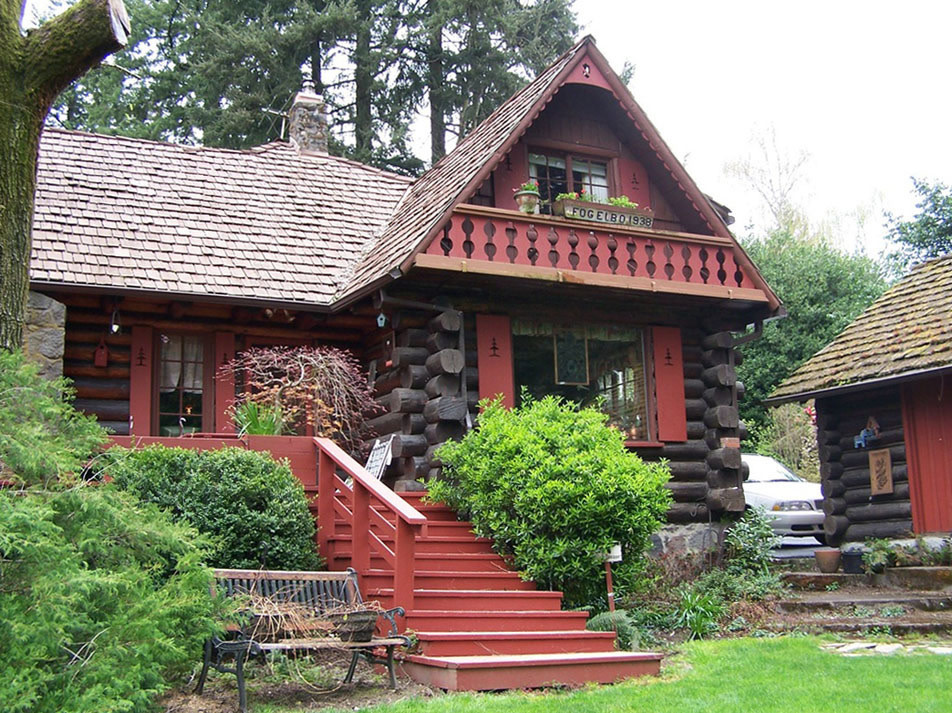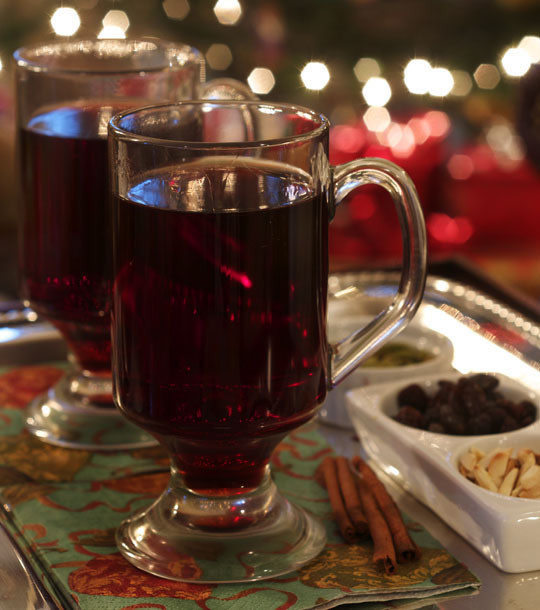Getting Punchy

Fogelbo, a log house built by Henry Steiner (a chief carpenter of Timberline Lodge) is the site of a holiday Swedish celebration, complete with glogg, later this month.
Our Scandinavian cohorts have mastered more than just modern design. Living in the far north of Europe, they deal with even darker winters than we do. Portland exists at about 46 degrees latitude; Sweden, by contrast, stretches roughly from the 56th to the 70th parallel (Stockholm sits just south of 60). They probably envy us our light. But we can envy them their glögg – and steal the recipe.
Glögg is a fortified winter warmer of spiced wine heated on the stove. It goes by many names, actually – nearly every culture has some sort of occasion for hot wine, but none more so than the Northern European lands. (Glühwein is the German word for it, also commonly heard here in the States.) And by the way, it's pronounced "glug" (similar to the sound you may make as you gulp it up; it goes down easy, so be careful.)

Here's a tried and true recipe for glögg from Urd Milbury, the Norwegian embassy's cultural affairs officer, in Washington, DC; she shared it with NPR last year and we've adapted it here. She tells us from experience: "Always taste – taste well before your guests come." Sounds like a good plan for holiday cheer.
Glögg (Norwegian Mulled Wine)
- 1 cup Aquavit (a Norwegian liquor made from potatoes; brandy or vodka are also OK)
- 2 cups Burgundy or pinot noir wine
- 2 cups Port wine
- 1/2 cup raisins
- 1/2 cup white sugar
- 2 cinnamon sticks
- 4 whole cloves
- 6 whole cardamom seeds (crush them by hand)
- 1 orange - for its peel, thinly shaved
- Ginger - one small piece, peeled and cut in half
- Blanched almonds, sliced (optional - garnish)
Soak 1/2 cup of raisins for 30 minutes in one cup of aquavit (a Norwegian spirit made with potatoes); Brandy or vodka can be used instead.
Put a large pot on the stove, over high heat. Add water and sugar to the pot, and stir with a wooden spoon until the sugar is completely dissolved.
Lower the heat to medium and add your spices - cinnamon (each stick broken in half); four whole cloves; six whole cardamom seeds, crushed by hand; a thinly shaved orange peel; and the ginger. Stir with wooden spoon. Do not allow the mix to come to a boil from this point on (or the alcohol will boil off).
Add the aquavit-raisin mixture, two cups of burgundy or pinot noir wine and two cups of port wine to the spicy mix in the pot.
Sweeten and spice to taste.
Strain, garnish with raisins and slices of blanched almond — and serve hot off the stove.
Note: The drink can be made a day ahead and kept covered, on the stove, at room temperature. Just reheat before serving.
For the young folk and those who are able to face their holidays sober, mulled cider is highly desirable and just as easy to, well, mull.
To celebrate with those who really know the secrets to winter warming, join the New Sweden Cultural Heritage Society December 15 at Fogelbo, the log house built in the late 1930s that now houses Ross Fogelquist and often opens to the public as host of events for the Swedish cultural group.
Glögg and traditional Swedish treats, at Historic Fogelbo “decorated in Swedish style for the holidays” at 8740 SW Oleson Road in Portland; two seatings, 1 pm and 3.30 pm. $25 to the public ($20 for members of the New Sweden Cultural Heritage Society). For more information, or to make a reservation, call Carol Tripp, 503-617-6826.
